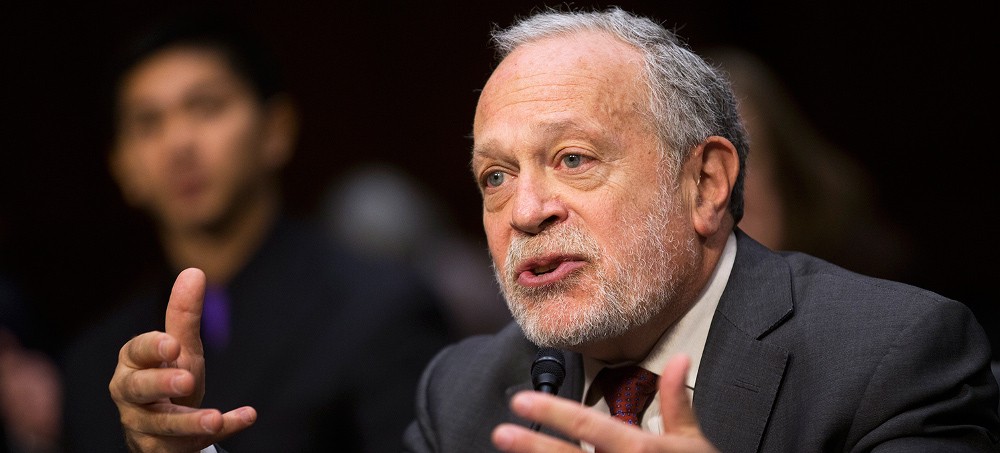
01 March 22
Live on the homepage now!
Reader Supported News
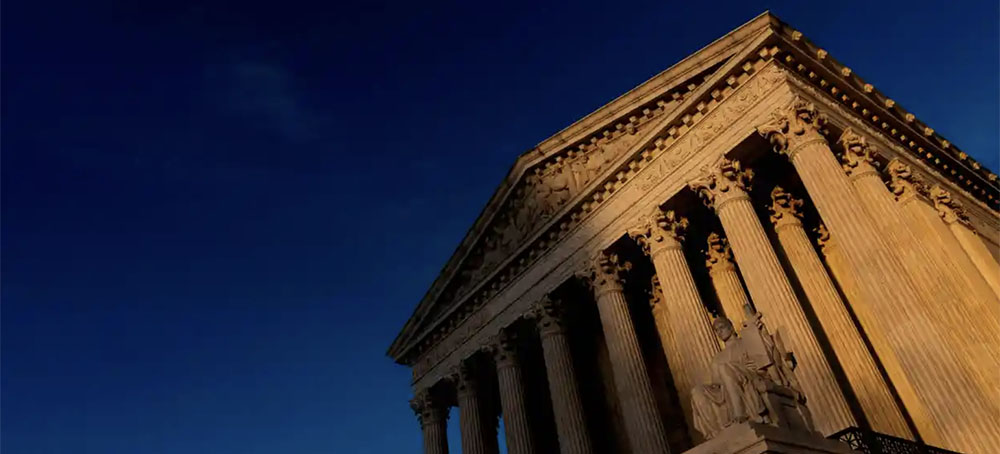
Laurence H. Tribe and Jeremy Lewin | The Rightwing US Supreme Court Has Climate Protection in Its Sights
Laurence H. Tribe and Jeremy Lewin, Guardian UK
Excerpt: "The court is breaking with precedent, procedure and prudence to achieve the ultra-conservative majority's policy preferences."
The court is breaking with precedent, procedure and prudence to achieve the ultra-conservative majority’s policy preferences
Granting a petition by several states and coal companies, the supreme court on 28 February will address what appears to be a technical legal question: does the Environmental Protection Agency have authority to calculate CO2 emissions targets for power plants based on mitigation techniques involving steps “beyond the fence-line” of individual plants? In truth, the matter the court is considering implicates –and imperils – the federal government’s power to fashion flexible solutions not only to global warming but to all manner of complex problems.
The stakes are higher still: by ruling on the case at all, the court usurps power constitutionally entrusted to government’s politically accountable branches. Article 3 of the constitution limits federal courts to deciding concrete “cases and controversies” about the rights of individual parties. Yet this “case” involves neither a concrete dispute nor the specific rights of any of the challengers. Instead, it’s akin to an exam question about the options theoretically available to a federal agency to address a grave problem. In answering that hypothetical question, the court will have arrogated to itself an unprecedented, open-ended power to reshape the nation’s social and economic landscape – far in excess of its legitimate authority, as the foundational case Marbury v. Madison put it, to “declare what the law is”.
The court has avoided such a wide-ranging role ever since our founding, when Chief Justice Jay refused President George Washington’s 1793 request for legal advice about America’s obligations under treaties with France and Britain, concluding that issuing such an “advisory opinion” to guide the nation’s foreign policy would exceed the court’s constitutionally assigned power. The underlying axiom is neither liberal nor conservative but universal. As Justice Brett Kavanaugh wrote for the court just last term, “federal courts decide only ‘the rights of individuals’ [and] do not possess a roving commission to publicly opine on every legal question.”
The role the court is poised to play in West Virginia v. EPA is more breathtaking still. It stands ready not just to “publicly opine” on a broad legal question but to bind the entire federal government to its answer, restricting the range of policies the EPA –under President Joe Biden and future presidents – can even consider to reduce carbon dioxide emissions and tackle climate change.
Issuing any such “super advisory opinion” would seize the power to set regulatory policy itself – a perversion of separation of powers unthinkable just a few years ago. Yet, as its recent onrush of breaks with precedent, procedure and prudence to achieve the ultra-conservative majority’s policy preferences on abortion, public health and voting rights demonstrate, today’s court flouts all institutional bounds. As it charges ahead, what remains of the court’s legitimacy, the constitution’s allocation of decision-making authority, and the planet’s future all hang in the balance.
How did we get here?
In 1970, Congress passed the Clean Air Act, empowering the new EPA to regulate dangerous pollutants like carbon dioxide to make our air safer; indeed, after the supreme court’s 2007 decision in Massachusetts v. EPA, the act requires EPA to seek lower CO2 emissions. One section tasks EPA with identifying the “best system of emissions reduction” that’s feasible to reduce CO2 from existing power plants, the largest category of stationary emitters.
In 2015, to meet American commitments under the Paris Climate Accords, President Barack Obama’s EPA promulgated the Clean Power Plan – an ambitious plan to shrink power sector emissions by more than 30%. It hinged on a central notion: the CAA’s “best system” language didn’t contemplate only reductions individual plants could achieve by themselves, but authorized EPA to consider reductions the entire electrical grid might achieve by working as an integrated whole. Thus, EPA could design, as its “best system”, a scheme in which power companies reduced emissions by substituting cleaner energy like renewables and natural gas for dirtier coal – a tactic known as “generation shifting”.
The plan was challenged on numerous legal grounds. Some insisted EPA could not so broadly construe the statutory word “system”, a claim difficult to square with the foundational doctrine of “Chevron deference,” under which courts defer to any “reasonable” agency interpretation of an “ambiguous” term like “system”. The senior author of this column challenged EPA’s plan on the narrower basis that EPA had rested its legislative authority on nonexistent power to choose which of two versions of the CAA Congress had enacted. In any event, the supreme court stayed the plan’s implementation in 2016 while the DC circuit sorted out its legality.
When Donald Trump was elected president months later, he sought to repeal the CPP. His EPA could have done so by just changing its preferred policy or legal interpretation, as supreme court doctrine readily permits agencies to do. But the Trump administration wanted more: to permanently foreclose any remotely similar plan. So it based its repeal on the mind-boggling theory that CAA’s text unambiguously barred not only CPP, but any system of emissions reduction that couldn’t be entirely effectuated within the “fence-lines” of stand-alone power plants. That interpretation barred not only generation shifting, but also far less controversial techniques like biomass co-firing (mixing biological material into portions of what coal plants burn for energy). This extreme reading was belied both by the basic functioning of our integrated, unitary power grid, and by previous EPA and supreme court interpretations of all relevant language. If the increasingly reactionary federal judiciary upheld that strained construction as mandatory, it would be locked in until Congress enacted a new regulatory framework. Realistically, that might mean forever.
Buttressing its twisted textual reading, Trump’s EPA invoked the “major questions doctrine” – an altogether amorphous weapon the court recently invented to strike the Center for Disease Control’s eviction moratorium and the Occupational Safety and Health Administration’s workplace vaccine-or-test mandate. Its premise is radical: wherever a court deems an agency’s policy choice to have resolved a “major question”, it must nullify that choice unless Congress, in enacting the relevant statute, anticipated the precise question and unmistakably authorized the agency’s precise answer.
That doctrine licenses judges to strike down whatever policy they disfavor – and invites agencies to opportunistically disclaim any regulatory authority they’d prefer not to exercise. It’s also inconsistent with the fact that contemporary social problems are too complex and interwoven with changing circumstances for Congress to predict every policy answer with technical precision, requiring that it legislate in broad terms and task expert agencies with filling in the details. Routinely applying the “major questions doctrine” might thus nihalistically nuke federal power to solve nearly any important problem.
Trump’s EPA did just that in repealing CPP, proclaiming itself categorically powerless to consider any “beyond the fence-line” emissions reduction systems because CAA either unambiguously precluded such consideration or failed unambiguously to empower such consideration, as the “major question” doctrine supposedly demanded.
Dozens of environmental groups and blue states challenged the repeal in court, and a day before Biden assumed office, the DC circuit held Trump’s interpretation not the only permissible reading of the text and struck down the repeal as legally flawed. Although CPP might have “snapped back” into force, the DC circuit stayed its judgment until Biden’s EPA could formulate a new rule. Given intervening legal developments – and years of rapid change in the power sector that achieved CPP’s emissions targets through free-market behavior – the agency had prudently asked for time to promulgate an entirely new rule.
This was a big win for the coal companies and CPP’s red-state opponents; with both the rule and its replacement stayed, no applicable regulation exists. None. When Biden’s EPA suggests a new rule, it will be immediately reviewable in federal court. Until then, CPP’s opponents have their wish: less federal CO2 regulation – in fact, none at all. In every sense, the dispute has become moot until EPA proposes a new rule imposing actual obligations on the states and companies.
Unsatisfied with that temporary victory, the states and coal companies filed several petitions asking the supreme court to hear the case and permanently lock in Trump’s defenestration of EPA’s authority – lest they be injured by what Biden’s EPA might someday propose if the court doesn’t proactively clip the agency’s wings. Given that no regulations currently apply, no clever framing can disguise the obvious: they’re asking the court for a “super advisory opinion”, prematurely answering an abstract question to preemptively bind an ideologically opposite administration before it has a chance to govern.
Equally worrying, several of the briefs urge the court to adopt extraordinarily broad understandings of when and how the “major questions” doctrine applies; to entirely overturn Chevron, one of the court’s most deeply entrenched precedents; and to gut nearly the entire CAA by reviving the long-dormant “non-delegation doctrine” – last employed by the ultra-conservative Lochner-era court to frustrate the New Deal in the 1930s. A super advisory opinion in this case has the potential not only to gut EPA’s power to regulate pollution and climate, but also to severely blunt the regulatory authority of nearly the entire federal government.
As one of us has written elsewhere, “law’s constraints are no match for power’s voracious appetite.” To an unaccountable tribunal of life-tenured, ideologically inclined justices, no doctrine presents an enforceable barrier to impulses of the most blatantly partisan variety. But hope is not yet lost. As the conservative Justice Antonin Scalia often emphasized, the ourt retains a “special obligation” to re-evaluate its own authority and to dismiss cases whenever jurisdictional defects are discovered. To hear this case, four justices sufficed; perhaps five others will recognize what centuries of precedent make clear: the court should dismiss the case and wait until an actual EPA regulation creates a concrete, live dispute. We can still urge and cautiously hope for that prudent approach; all the justices “are, in the end, masters of their craft and know that their power requires them to act as lawyers”.
READ MORE
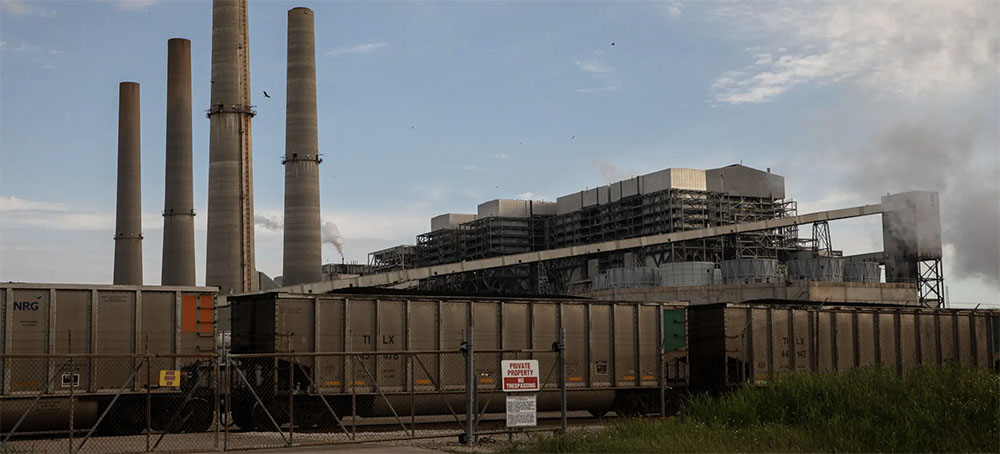 A coal-fired power plant in Thompsons, Texas. Last year a federal appeals court in Washington struck down the Trump administration's plan to relax restrictions on greenhouse gas emissions from power plants. (photo: Tamir Kalifa/NYT)
A coal-fired power plant in Thompsons, Texas. Last year a federal appeals court in Washington struck down the Trump administration's plan to relax restrictions on greenhouse gas emissions from power plants. (photo: Tamir Kalifa/NYT)
Supreme Court Considers Limiting EPA's Ability to Address Climate Change
Lauri Foti, The New York Times
Foti writes: "Members of the Supreme Court's conservative majority on Monday questioned the scope of the Environmental Protection Agency's ability to regulate carbon emissions from power plants, suggesting that the court could deal a sharp blow to the Biden administration's efforts to address climate change."
Members of the Supreme Court’s conservative majority on Monday questioned the scope of the Environmental Protection Agency’s ability to regulate carbon emissions from power plants, suggesting that the court could deal a sharp blow to the Biden administration’s efforts to address climate change.
The questioning during the two-hour argument was mostly technical, and several conservative justices did not tip their hands. But those who did sounded skeptical that Congress had meant to give the agency what they said was vast power to set national economic policy.
There appeared to be little appetite for an argument pressed by the Biden administration and environmental groups: that the four cases before the justices, including West Virginia v. Environmental Protection Agency, No. 20-1530, were not ripe for decision because there is no regulation in place. They said the court should wait to address concrete questions rather than ruling on hypothetical ones.
Solicitor General Elizabeth B. Prelogar said the administration was at work on a new regulation, which the courts could consider after it was issued.
Chief Justice John G. Roberts Jr. and Justice Stephen G. Breyer indicated that they thought the Supreme Court did not need to wait.
Much of the argument was focused on whether the Clean Air Act allowed the agency to issue sweeping regulations across the power sector and, more broadly, of how clearly Congress should authorize executive agencies to address major political and economic questions.
Last year, on the last full day of Donald J. Trump’s presidency, a federal appeals court in Washington struck down his administration’s plan to relax restrictions on greenhouse gas emissions from power plants. The Trump administration said the Clean Air Act unambiguously limited the measures the agency could use those “that can be put into operation at a building, structure, facility or installation.”
A divided three-judge panel of the court, the U.S. Court of Appeals for the District of Columbia Circuit, ruled that the Trump administration’s plan, called the Affordable Clean Energy Rule, was based on a “fundamental misconstruction” of the relevant law, prompted by a “tortured series of misreadings.”
“The E.P.A. has ample discretion in carrying out its mandate,” the decision concluded. “But it may not shirk its responsibility by imagining new limitations that the plain language of the statute does not clearly require.”
The panel did not reinstate a 2015 Obama-era regulation, the Clean Power Plan, which would have forced utilities to move away from coal and toward renewable energy to reduce emissions. But it rejected the Trump administration’s attempt to replace that rule with what critics said was a toothless one.
The appeals court’s ruling also cleared the way for the Biden administration to issue stronger restrictions.
The Obama-era plan had aimed to cut emissions from the power sector by 32 percent by 2030 compared with 2005 levels. To do so, it instructed every state to draft plans to eliminate carbon emissions from power plants by phasing out coal and increasing the generation of renewable energy.
The Obama administration’s Clean Power Plan never came into effect. It was blocked in 2016 by the Supreme Court, which effectively ruled that states did not have to comply with it until a barrage of lawsuits from conservative states and the coal industry had been resolved. That ruling, followed by changes in the Supreme Court’s membership that have moved it to the right, has made environmental groups wary of what the court might do in cases on climate change.
On Monday, the Intergovernmental Panel on Climate Change, a body of experts convened by the United Nations, published the most comprehensive look to date at the threats that global warming poses to homes, human health, livelihoods and natural ecosystems around the world. The report, approved by 195 governments, found that the dangers from climate change are bigger and unfolding faster than previously affected and that humanity may struggle to adapt to the consequences unless greenhouse gas emissions are quickly reduced in the next few decades.
“Any further delay in concerted anticipatory global action,” the report said, “will miss a brief and rapidly closing window of opportunity to secure a livable and sustainable future for all.”
READ MORE
 A Ukrainian infantry combat vehicle on the outskirts of Kyiv, Ukraine, Feb. 24, 2022. (photo: Daniel Leal/AFP/Getty Images)
A Ukrainian infantry combat vehicle on the outskirts of Kyiv, Ukraine, Feb. 24, 2022. (photo: Daniel Leal/AFP/Getty Images)
In Ukraine's West, Conscripts of All Ages Head to Battle, Expressing Outrage at Putin's Invasion
John Bolger, The Intercept
Bolger writes: "The conscriptions, reluctant or not, are part of a broad, societywide mobilization by Ukraine to fend off a vastly superior Russian military force."
“Your President Biden said that God will help us. Of course, we hoped for American and European help.”
By the second day of the Russian invasion of Ukraine, everything in Khmelnytskyi had changed. As the Russian military breached Kyiv, the capital, and people fled en masse, this western Ukrainian city of nearly 300,000 swelled with activity. Tension took hold as resources became sparser. And the Ukrainian army had set up sandbags as an impromptu registration desk for signing up conscripts.
With the blue and yellow of Ukraine’s flag streaming from every lamppost, some 100 men between the ages of 18 and 60 lined up to board buses leaving for active duty. With martial law declared on the first day of the conflict, they had become required to serve.
Rumors, social media, and news reports gave accounts of buses being stopped at Ukraine’s borders so that men planning to leave could be offloaded to join the fight. But in the city center of Khmelnytskyi, they were ready to enlist — unafraid, if not exactly thrilled — to protect their country.
“Now is no time for feelings. If it is necessary to go to war, then that’s what it is,” said Viktor, 58, the owner of a medical business, who like other conscripts interviewed for this story declined to give his last name. “We are proud to do this for our country.”
The conscriptions, reluctant or not, are part of a broad, societywide mobilization by Ukraine to fend off a vastly superior Russian military force. In addition to mandatory military service, civilians are reportedly taking up arms in Kyiv, and the Defense Ministry told citizens to “make Molotov cocktails.”
In more than a dozen interviews for this article conducted over two days in Khmelnytskyi — including with conscripts, soldiers, refugees, and journalists — there was unanimity that Ukraine was being abandoned by the international community. The men lamented that, under President Joe Biden, the U.S. was not intervening militarily in the war.
“Your President Biden said that God will help us,” said one conscript, Vasily, 49, who also asked that his last name not be used. “Of course, we hoped for American and European help. But we were left naked!”
The young and the old alike waited their turn as military officers made the rounds with a clipboard of names. None of the draftees knew where they might be headed next.
Ukrainian President Volodymyr Zelensky’s declaration of martial law, made within hours after the first Russian bombs began to fall, along with a state of emergency enacted by the legislature the day before, gave the government broad discretion to restrict free movement and suspend civil liberties. This general mobilization of conscripts and reservists falls under the special authorities.
“My country needs me,” said a state historian, 47, who had been conscripted and who declined to give his name. “I’m here because I’m a patriot.”
Khmelnytskyi, about 170 miles southwest of Kyiv, remains peaceful for now. Many speculated before the war that western Ukraine would be spared, but the conscripts doubted it. A military target just 25 miles north of the city, in the village of Starokostiantyniv, had already been bombed on the first day of the invasion; by Saturday, businesses closed as unconfirmed rumors of impending rocket strikes circulated through the city.
The historian pointed the finger at the aggression from Russia and its president, Vladimir Putin, invoking the last existential crisis to hit Ukraine: World War II. “Russia has violated all moral, ethical, and social principles and values,” he said. “Russia attacked us like Nazi Germany once did.”
Vasily, the conscript, spoke about the post-Soviet agreement Ukraine made to denuclearize its military in exchange for guaranteed territorial integrity: “Is the Budapest Memorandum not still valid?”
In 1994, Russia signed the so-called Budapest Memorandum — along with the U.S., the U.K., Belarus, and Kazakhstan — but broke it with its 2014 invasion and annexation of the Ukrainian peninsula of Crimea, a strategic port region in the Black Sea. The invasion force besieging Kyiv from the north today was mobilized through Belarus.
“We are very grateful to the States for the weapons, but it’s not enough now,” Vasily said of weapons deliveries by the U.S. in the runup to the war. The U.S. has provided hundreds of millions of dollars in military aid and huge numbers of weapons to Ukraine since January but has committed to staying out of direct combat.
Vasily dismissed concerns in the West that a NATO or U.S. intervention would spark a conflagration between nuclear superpowers. “Let them worry!” he said. “If Putin takes Ukraine today, tomorrow it will be Latvia and Poland, and he will go on!”
READ MORE
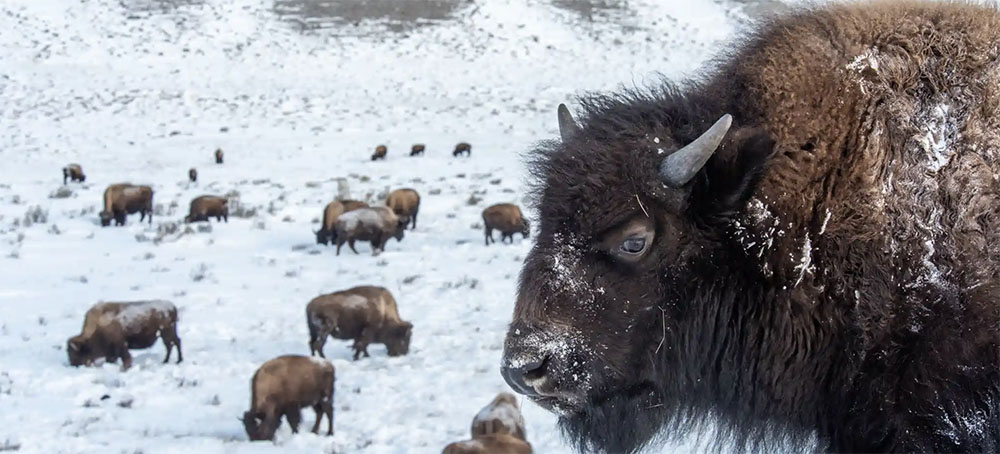 Yellowstone National Park, Wyoming, home to bisons and other large mammals including grizzly bears, elks and wolves, became a national park in 1872. (photo: William Campbell/Getty Images)
Yellowstone National Park, Wyoming, home to bisons and other large mammals including grizzly bears, elks and wolves, became a national park in 1872. (photo: William Campbell/Getty Images)
Yellowstone at 150: Busier Yet Wilder Than Ever, Says Park's 'Winterkeeper'
Todd Wilkinson, Guardian UK
Wilkinson writes: "As 'winterkeeper' at Yellowstone national park, Steven Fuller lives in a rustic cedar-shingled cottage, built in 1910, set on a hill a short walk from the majestic Grand Canyon of the Yellowstone."
From the return of wildlife to the pressures of tourism and the climate crisis, Steven Fuller has seen it all in his nearly 50 years watching over America’s oldest national park
As “winterkeeper” at Yellowstone national park, Steven Fuller lives in a rustic cedar-shingled cottage, built in 1910, set on a hill a short walk from the majestic Grand Canyon of the Yellowstone.
On balmier days, with the windows open, he can hear the roar of the 308ft Lower Falls tumbling into the chasm. In autumn, he is treated to the sound of bugling bull elk in rut or, in the middle of night, the howls of wolves.
A key part of Fuller’s professional responsibility in winter, when deep snow and bone-chilling cold shuts down tourist operations for five months in the centre of Yellowstone, is removing snow from building rooftops to prevent them from collapsing under the weight of the load.
His solitary existence might seem idyllic, but when Fuller and his English wife, Angela, landed the winterkeeping assignment in 1973, there wasn’t a long line of competitors. He was the only applicant.
“Back then, being a winterkeeper at Canyon was considered a hardship post where the isolation was reputed to drive people crazy,” Fuller remembers, noting they had no phone or TV and the internet was decades away. In the evenings, they listened to BBC news broadcasts via shortwave radio.
“Then again, in those days, the world seemed a much bigger place, with fewer of us on the planet and such a thing as solitude wasn’t in short supply,” he adds.
Today, the proliferation of digital technology, which enables faster-paced park visitors to share a selfie on social media from the remotest mountain peaks, has made Yellowstone’s vastness feel smaller, he says.
The bittersweet lament comes as Yellowstone marks its 150th anniversary on 1 March as America’s first national park and one of the first in the world. For Fuller it coincides with his 49th year as Yellowstone winterkeeper, the longest anyone has held the post in the park’s history.
“Going back to the 19th century, winterkeepers tended to be basically backwoods good ol’ boys, and not necessarily with a high level of education,” retired Yellowstone park historian Lee Whittlesey says. “They were looked upon as refugees from civilisation, trying to get away by hiding out as hermits. Steve Fuller has done a lot to change that prosaic image, but he has his own Thoreauvian place as an anomaly in the 21st century.”
Fuller says the changes he has observed in Yellowstone have been profound. “It’s difficult sometimes to sort out the paradoxes,” he says.
Yellowstone is coping with record numbers of visitors and yet, Fuller notes, the park is in some ways wilder than when he arrived.
Grizzly bears, whose numbers in the park dipped to just 136 in the 1970s, have been rescued from a population freefall. Wolves, deliberately exterminated by park rangers in the 1920s, were brought back in the mid-1990s. And bison population, which numbered just 23 at one point in the late 19th century, is today at 5,000.
In 1973, the year Fuller arrived, there were slightly more than 2 million visits recorded in Yellowstone. Last year, Covid-19 set off a rush of people to the park and there were nearly 4.9 million – 800,000 more than in 2019, the year before the pandemic struck. This year, given the publicity for the park’s 150th anniversary, Yellowstone may surpass 5 million visitors.
Tourism brings millions of dollars in revenue to neighbouring communities and creates thousands of jobs but the growing numbers have come at a cost, says Fuller.
“Traffic congestion in summer is a lot worse – a lot. I experience it first-hand,” Fuller says. “I’m reluctant to go anywhere in the park during the day when I have free time. You might set out on a drive that would ordinarily take you 30 minutes, but the chances of getting stuck in traffic and taking three times as long are good.”
Most tourists stick to the roads and short trails, directly affecting only about 2% of the park’s 8,900 sq km (2.2m acres), notes Yellowstone superintendent Cam Sholly. Scenes of traffic gridlock and full carparks are real, but they create an inaccurate perception, Sholly says. Most of Yellowstone is sparse of people and the farther one wanders away from the asphalt, the more likely it is that wildlife outnumbers those on two legs.
The crowdless backcountry serves as an important refuge for wildlife, but this space is shrinking amid a development boom in the Rocky Mountain west. Sholly is also concerned about the climate crisis dramatically altering habitats for wildlife, and the growing threat of exotic plants overtaking native species that support the health of animals such as elk, deer, pronghorn and bison.
Fuller echoes Sholly’s worries. “We’ve had 20 below [fahrenheit] with more frequency, but not the deep cold stretches of minus 30, minus 40, sometimes 50 below that were a defining aspect of winter here,” Fuller says. “While weather swings are normal, the trend, overall, is in the direction of earlier spring meltoff.”
His perception is corroborated by scientific evidence. Over the last half century, the growing season (the time between the last freeze of spring and the first freeze of autumn) has increased by 30 days in the park’s valleys. Meanwhile, near Yellowstone’s north-east entrance, which has typically been colder than other parts of the park, scientists say there are 80 more days a year above freezing than in the 1960s. Such conditions mean the snowpack is melting during winter and leaving the mountains earlier in spring, which causes some rivers to run lower in late summer and drier forests, which are more susceptible to wildfire.
Despite the challenges, Fuller could not imagine living anywhere else. Fuller says the park still offers important lessons to other parts of the world, including the UK.
Fuller considers himself a proud anglophile. He spent one of his college years at Leeds University. A few years later, he fell in love with Angela and married her. They spent time in Uganda and raised two daughters in Yellowstone, home schooling them into their teens.
With the Yellowstone ecosystem holding the distinction of having the largest concentration of mammals in the lower 48 states, lessons in how humans and wildlife can better coexist abound.
Fuller shares stories of the bison that recently trudged past his window and rested in the snow near a walkway leading to his front door, and of grizzlies, including mother bears with cubs, ambling around his “wild neighbourhood”, or seeing the aftermath of a successful wolf predation on an elk, and foxes and coyotes routinely mousing in the meadows.
Fuller knows that many animals in Yellowstone can be dangerous, and he is under no false illusion about them seeking close human companionship, as one might see portrayed by Hollywood. He has never been injured, but he often gives wildlife a wide berth out of respect for their space.
“The older I’ve become, the more I’ve begun to appreciate the sentient connections between living things here and the places they inhabit,” he says.
“In 1872, when Yellowstone was created, I don’t think the US Congress could have possibly imagined how vital, as a symbol, this place would be in our time. Protecting nature for its own sake was a remarkable expression of foresight that we are only now beginning to fully understand.”
READ MORE
 Vaccination. (photo: Robyn Beck/AFP/Getty Images)
Vaccination. (photo: Robyn Beck/AFP/Getty Images)
New Data Shows Pfizer Vax Is Almost Useless in Preventing COVID Infection in Kids Age 5 to 11
Rachel Olding, The Daily Beast
Olding writes: "A huge batch of data collected by New York State has shown disappointing findings: The Pfizer vaccine offers next to no protection against coronavirus infection for kids age 5 to 11 and is less effective at preventing hospitalization compared to adults and teens."
A huge batch of data collected by New York State has shown disappointing findings: The Pfizer vaccine offers next to no protection against coronavirus infection for kids age 5 to 11 and is less effective at preventing hospitalization compared to adults and teens. The study of almost a million vaccinated kids showed that the jab offered almost no protection against infection, even in the first few weeks after vaccination. While the jab is still effective at preventing serious illness, its effectiveness in preventing hospitalization for older children dropped to 73 percent and for younger children it dropped to 48 percent. However, health officials cautioned that the estimates have a wide margin of error because child hospitalizations are so rare. The New York Times reports the results may stem from the fact young kids get a much lower dose than teens and adults. Pfizer’s jab is the only vaccine authorized for kids age 5 to 11.
READ MORE
 Amber Payne, left, and Deborah Douglas co-editors-in-chief of the new online publication of 'The Emancipator' pose at their office inside the Boston Globe, Wednesday, Feb. 2, 2022, in Boston. Boston University's Center for Antiracist Research and The Boston Globe's Opinion team are collaborating to resurrect and reimagine The Emancipator, the first abolitionist newspaper in the United States, which was founded more than 200 years ago. (photo: Charles Krupa/AP)
Amber Payne, left, and Deborah Douglas co-editors-in-chief of the new online publication of 'The Emancipator' pose at their office inside the Boston Globe, Wednesday, Feb. 2, 2022, in Boston. Boston University's Center for Antiracist Research and The Boston Globe's Opinion team are collaborating to resurrect and reimagine The Emancipator, the first abolitionist newspaper in the United States, which was founded more than 200 years ago. (photo: Charles Krupa/AP)
America's First Abolitionist Newspaper Is Born Anew in the Digital World
Alexandra Jane, The Root
Jane writes: "It was the first ever publication 'to advocate the abolition of slavery, and to be a repository of tracts on that interesting and important subject.'"
After 200 years, the nation’s first abolitionist newspaper is returning–and it couldn’t have come back at a better time.
In an unfortunate way, what is old often becomes new again when considering the history of the world. With recent news of Ukraine’s bombing at the hands of Russian leaders depicting scenes reminiscent of World War II, a deadly ongoing pandemic, and acts of everyday, overt racism taking over our newsfeeds, its easy to question what era we’re living in. In an effort to fight old battles however, some are uncovering old tools of defense.
Meet Deborah Douglas and Amber Payne, co editors of a revived version of The Emancipator, America’s first abolitionist newspaper set to be launched later this year. With the collaborative assistance of Boston University’s Center for Antiracist Research and The Boston Globe’s Opinion team, Douglas and Payne are using academic research and journalism as weapons against the legacy of racism, much as journalism was once used to abolish slavery, lynching, and other criminal and discriminatory practices.
“I like to say it’s anti-racism, every day, on purpose,” Douglas stated to HuffPost reporters. “We are targeting anyone who wants to be a part of the solution to creating an anti-racist society because we think that leads us to our true north, which is democracy.”
The Emancipator was first published in 1820, and founded by iron worker Elihu Embree of Jonesborough, Tennessee. According to the University of Tennessee Knoxville libraries, it was the first ever publication “to advocate the abolition of slavery, and to be a repository of tracts on that interesting and important subject.” The newspaper reached a circulation of over 2,000 in cities such as Boston and Philadelphia, which were considered centers of the abolitionist movement. While the legacy of the publication stretches over two centuries, its actual time in print was short lived. Not even a full year after its first issue, production was halted after the untimely death of its founder, Embree. Now, Douglas and Payne’s team of researchers and reporters are reviving it on a digital platform to make it accessible to the masses.
“This is really deep reporting, deep research and deep analysis that’s scholarly driven but written at a level that everyone can understand,” Douglas said. “Everybody is invited to this conversation. We want it to be accessible, digestible and, hopefully, actionable.”
After serving as the managing editor at BET.com and as an executive producer at Teen Vogue, Amber Payne’s contribution to the new Emancipator includes a focus on highlighting solutions to the nation’s race problems, and utilizing a myriad of methods to do so.
“There are community groups, advocates and legislators who are really taking matters into their own hands so how do we amplify those solutions and get those stories told?” she said. “At the academic level, there’s so much scholarly research that just doesn’t fit into a neat, 800-word Washington Post op-ed. It requires more excavation. It requires maybe a multimedia series. Maybe it needs a video. So we think that we are really uniquely positioned.”
The publication also serves a great purpose when it comes to putting a stop to the spread of misinformation. At a time when there are debates around how to teach the history of Black Americans, and banning books that address racism and abolitionist ideologies, the revival of The Emancipator is perfectly timed.
“Our country is so polarized that partisanship is trumping science and trumping historical records,” Payne said. “These ongoing crusades against affirmative action, against critical race theory are not going away. That drumbeat is continuing and so therefore our drumbeat needs to continue.”
READ MORE
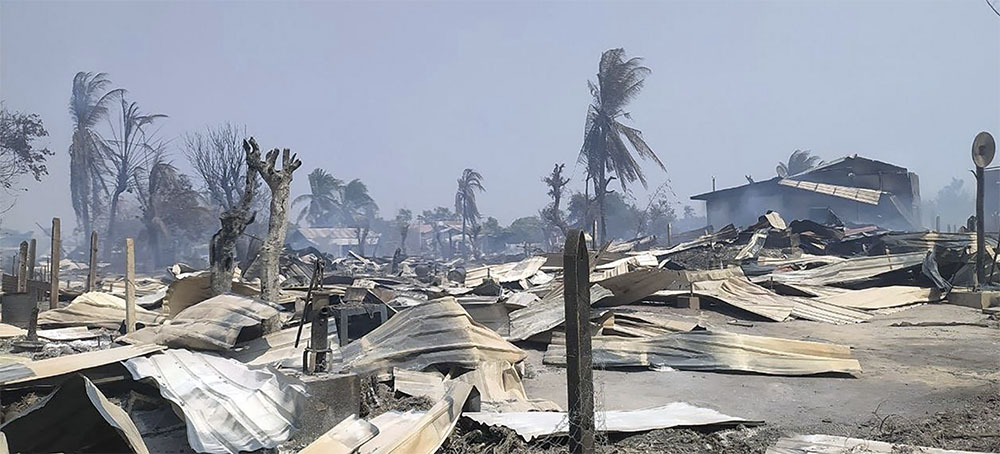 Soldiers burned around 400 houses in Hna Ma Sar Yit village last week. (photo: Myanmar Now)
Soldiers burned around 400 houses in Hna Ma Sar Yit village last week. (photo: Myanmar Now)
Junta Soldiers in Upper Myanmar Burn Hundreds of Homes and Murder Civilians During Rampages
Khin Yi Yi Zaw and Ko Cho, Myanmar Now
Excerpt: "In Shwebo Township on Friday, 50 soldiers and Pyu Saw Htee militiamen burned around 400 homes in the village of Hna Ma Sar Yit. Locals later found the bodies of three residents and said three others, who were all elderly, had gone missing."
One of those killed was found with severe injuries on his body, suggesting he had been tortured, a local resident said
Junta soldiers killed civilians, burned hundreds of homes, and destroyed food stocks during attacks on villages in Sagaing Region last week, locals said.
Troops entered Kan Lay Kone village in Taze Township on February 21 and abducted 43-year-old Soe Moe, who they then took to another village five miles away called Thapyay Inn, according to the locals.
He was found dead on Thursday with his hands tied behind his back near a stream in Thapyay Inn. “We think he was tortured for three whole days,” said one local man. “There were a great number of injuries on the body.”
It was unclear why he was targeted, the man added. “He was on his way to check on his relatives when he ran into the junta column,” he said.
Elsewhere in Taze, Nay Win Htun, 40, was shot dead in his village of southern Chaung Sone on Friday. Locals said the soldiers threw the man’s body into his house, which they then set fire to.
Another junta column entered Taze from Kanbalu Township and raided the villages of Kan Phyu, Wat Toe and Thar Khaung Gyi on February 24, according to Taze locals.
“They’ve been terrorising those villages for three days,” said one resident. “They also torched houses that were not destroyed by artillery shells. And they killed and ate the cows in the village. They’re just doing whatever they want.”
In Shwebo Township on Friday, 50 soldiers and Pyu Saw Htee militiamen burned around 400 homes in the village of Hna Ma Sar Yit. Locals later found the bodies of three residents and said three others, who were all elderly, had gone missing.
“They started firing shots at around 6am,” said one local man, adding that the attackers used both heavy and light weapons.
Yin San Aye, 33, and U Thein, 55, were later found dead with bullet wounds, while 77-year-old Khin Than died in a fire in her home, he added.
Tons of rice were also destroyed in the fires. This is the fourth time the village of some 600 houses had been attacked by the junta’s forces.
“I don’t even have the words to describe what we’re feeling right now. I would understand if we were armed and posed a threat to them. We weren’t armed in any way. The villagers were fleeing but they just kept on firing. It’s just too cruel,” the local man said.
The Pyu Saw Htee members who joined the soldiers came from Thee Lone, Pan Yan and Myin See villages, he added.
A local woman told Myanmar Now her house was burned after she fled the village with her eldery parents.
“Once all of us had fled, they started torching the houses in the southern part of the village until they reached the middle. And then my house was torched. We could also hear them yelling that they would kill anyone they saw,” she said.
Residents say many in the village have taken part in anti-coup protests.
Local news reports said thousands have been displaced by military raids on the Shwebo villages of Ywar Soe, Pauk Chaing and Seikkhun.
Soldiers burned another 40 houses with shelling in Shwebo’s Ngarpi Oe village on Thursday and killed a 25-year-old man, villagers and a local resistance force leader there said.
The attack came as retaliation after a Pyu Saw Htee leader named Myint Than was killed along with another man named La Yaung. Junta forces in the nearby village of Gway Pin Kone opened at Ngarpi Oe using artillery.
“We didn’t have enough time to do anything at all,” said the resistance force leader. “The battle was totally unexpected. They started to fire artillery shells right after the Pyu Saw Htee leader got killed.”
“We don’t have enough equipment or weapons to fight back. They continuously used heavy artillery shells. It was really overkill, considering the civilians were unarmed,” he added.
The 25-year-old man was shot dead while fleeing the attack on his motorcycle at around 9pm, he added. The fires raged until Friday morning.
“They wouldn’t have needed to use this much force even if it had been an actual battle. There were only 20 seconds between each heavy artillery shell. We couldn’t do anything but retreat,” the resistance fighter added.
The village sits along the Shwebo-Kyaukmyaung road near the entrance to the UNESCO world heritage site of Hanlin, which contains archeological ruins from the Pyu era.
“The place where the shells fell is only 15,000 feet away from the Han Lin city gate. The shell essentially fell in preserved territory,” said a 60-year-old villager named Lin.
Another man, 40, said a two-storey house, a barn and 410 litres of rice grain were also destroyed by the shells, while six cows were killed.
Over 5,000 people have fled Ngarpi Oe and the nearby villages of Gyoegyar, Kan Gyi Taw, Ywar Thit Kone and Thea Kyun because of the attacks, according to locals.
READ MORE
Special Coverage: Ukraine, A Historic Resistance
https://www.rsn.org/001/ukraine-a-historic-resistance.html
Contribute to RSN
Follow us on facebook and twitter!
Update My Monthly Donation
PO Box 2043 / Citrus Heights, CA 95611

